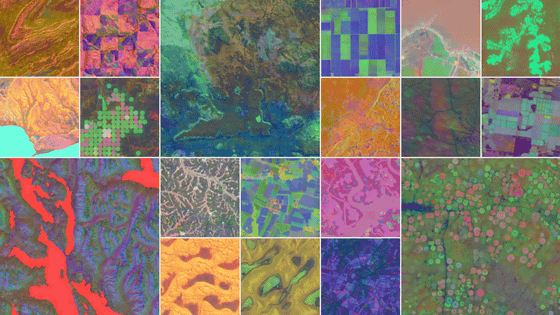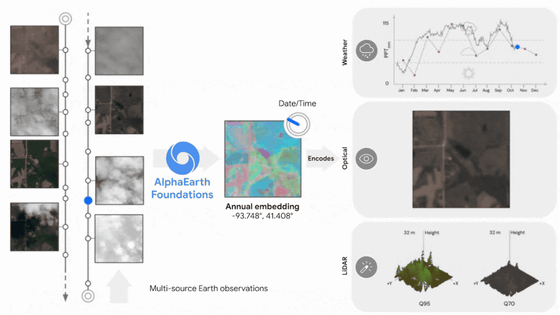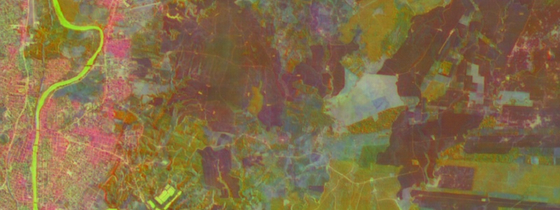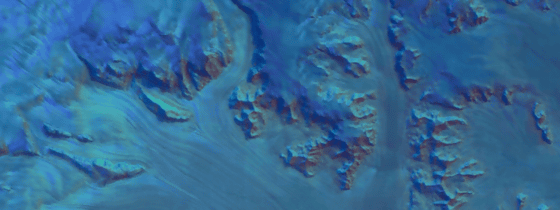Google launches 'AlphaEarth Foundations,' an AI for mapping the Earth's environment, enabling rapid mapping of crops, deforestation, and other conditions

Google DeepMind has announced ' AlphaEarth Foundations ,' an AI model that can integrate vast amounts of Earth observation data to create global maps. The data created by AlphaEarth Foundations has also been compiled into a dataset called ' Satellite Embedding V1 ,' which has been made available on Google Earth Engine.
AlphaEarth Foundations helps map our planet in unprecedented detail - Google DeepMind
AI-powered pixels: Introducing Google's Satellite Embedding dataset | by Google Earth | Google Earth and Earth Engine | Jul, 2025 | Medium
https://medium.com/google-earth/ai-powered-pixels-introducing-googles-satellite-embedding-dataset-31744c1f4650
Satellite Embedding V1 | Earth Engine Data Catalog | Google for Developers
https://developers.google.com/earth-engine/datasets/catalog/GOOGLE_SATELLITE_EMBEDDING_V1_ANNUAL?hl=ja#description
Every day, satellites capture information-rich images and measurements, providing scientists and experts with a near-real-time view of Earth. However, the data they capture is complex, comes in many different formats, and is updated at different rates, making it difficult to compile into a single dataset.
Google DeepMind's AlphaEarth Foundations is a new AI model that acts like a virtual satellite. It integrates vast amounts of Earth observation data from dozens of public sources, including optical satellite imagery, radar, and 3D laser mapping, and converts it into a single digital dataset called an 'embedding.' This enables accurate and efficient analysis of the state of land and coastal waters across the globe at a high resolution of 10x10 meters, and tracks changes over time with remarkable accuracy.

Below is a photo of agricultural land mapping from satellite imagery in Ecuador. AlphaEarth Foundations' embedded field uses 64 dimensions, with red, green, and blue assigned to three of them.

Below is the surface of Antarctica generated by AlphaEarth Foundations. Because satellite images are irregular, it has been difficult to image the surface of Antarctica with conventional technology, but this photo shows the terrain beautifully in three dimensions.

Additionally, AlphaEarth Foundations can summarize information for each plot into extremely compact data that is 16 times smaller than other AI systems, significantly reducing the cost of analysis at a global scale. This solves traditional challenges of data overload and inconsistent information, enabling scientists to create detailed, consistent maps on demand to monitor critical issues such as deforestation, food security, and urban sprawl.
And Google Earth Engine's 'Satellite Embedding V1,' powered by AlphaEarth Foundations, boasts over 1.4 trillion embedded footprints annually, making it the largest dataset of its kind. This annual collection of embeddings is already being used by organizations around the world, including the Food and Agriculture Organization of the United Nations, Harvard University, the Group on Earth Observations, MapBiomas , Oregon State University, and Stanford University.
In Brazil specifically, MapBiomas is testing Satellite Embedding V1 to better understand agricultural and environmental changes across the country. This type of map will provide important information for conservation strategies and sustainable development planning in threatened ecosystems like the Amazon rainforest.
Google DeepMind said, 'We are using this model to generate annual embeddings, but we believe that in the future it will be even more useful when combined with general-purpose large-scale language model (LLM) agents like Gemini. We will continue to explore how best to apply the model's time-based capabilities as part of Google Earth AI, a collection of geospatial models and datasets to address Earth's most important challenges.'
Related Posts:







